Current resource assessment in Brunei’s coastal waters
AHMAD FARID Dato Hj Ali, ROSLYNNA Rosli
download PDFAbstract. Current Resource Assessment plays a major part in Tidal Energy Resource Assessment. The paper looks at analysing the total current data collected from BSP at Fairley Oilfield from 1st January 2019 up to 31 December 2019. The total current data and its direction was measured using ADCP, and is placed at an area with a depth of about 60m. The data is categorized into 3 depths; current speed and direction for overall depth, current speed and direction for top half of the sea, current speed and direction for bottom half of the sea. According to the current speed for the overall depth, the current speed was recorded to have an average speed of 0.27m/s and a maximum speed of 1.4m/s. For the current speed and direction at the top half of the sea, the current speed was recorded to have an average speed of 0.33m/s and a maximum speed of 2.24m/s. Finally, for current speeds at the bottom part of the sea, the current speed has an average of 0.22m/s and a maximum speed of 1.66m/s. The direction for all three categorizes were consistent in which the flow is recorded to be coming in from the East-North East to East, majority of the time.
Keywords
Tidal Current, Tidal Resource, Resource Assessment, Tidal Energy, Brunei
Published online 5/20/2023, 7 pages
Copyright © 2023 by the author(s)
Published under license by Materials Research Forum LLC., Millersville PA, USA
Citation: AHMAD FARID Dato Hj Ali, ROSLYNNA Rosli, Current resource assessment in Brunei’s coastal waters, Materials Research Proceedings, Vol. 29, pp 472-478, 2023
DOI: https://doi.org/10.21741/9781644902516-53
The article was published as article 53 of the book Sustainable Processes and Clean Energy Transition
![]() Content from this work may be used under the terms of the Creative Commons Attribution 3.0 license. Any further distribution of this work must maintain attribution to the author(s) and the title of the work, journal citation and DOI.
Content from this work may be used under the terms of the Creative Commons Attribution 3.0 license. Any further distribution of this work must maintain attribution to the author(s) and the title of the work, journal citation and DOI.
References
[1] Horstman E. M., Wijnberg K. M., Smale A. J., & Hulscher S. J. M. H., 2009. Long-term Coastal Management Strategies: Useful or Useless? Journal of Coastal Research, 233-237.
[2] Richardson A. J., Brown C. J., Brander, K. Bruno, J. F., Buckley L., Burrows M. T., … Poloczanska, E. S., 2012. Climate change and marine life. Biology Letters, 8(6), 907-909. https://doi.org/10.1098/rsbl.2012.0530
[3] David A. J., Adam D., Deborah I., Eric W. P., 2021. Tides and Coastal Geomorphology: The Role of Non-Stationary Processes. Treatise on Geomorphology, 161-198. https://doi.org/10.1016/B978-0-12-818234-5.00166-8
[4] Bryden I. G., Couch S. J., Owen A., and Melville G., 2007. Tidal current resource assessment. Proceedings of the Institution of Mechanical Engineers, Part A: Journal of Power and Energy, 221(2), 125-135. https://doi.org/10.1243/09576509JPE238
[5] Lemonis G., 2004. Wave and Tidal Energy Conversion. Encyclopedia of Energy, 385-396. https://doi.org/10.1016/B0-12-176480-X/00344-2
[6] Boretti A., 2020. Trends in tidal power development. E3S Web of Conferences, 173, 01003. https://doi.org/10.1051/e3sconf/202017301003
[7] Liu X., Chen Z., Si Y., Qian P., Wu H., Cui L., & Zhang D., 2021. A review of tidal current energy resource assessment in China. Renewable and Sustainable Energy Reviews, 145, 111012. https://doi.org/10.1016/j.rser.2021.111012
[8] Uihlein A., and Magagna D. 2016. Wave and tidal current energy – A review of the current state of research beyond technology. Renewable and Sustainable Energy Reviews, 58, 1070-1081. https://doi.org/10.1016/j.rser.2015.12.284
[9] Lewis M., O’Hara Murray R., Fredriksson S., Maskell J., de Fockert A., Neill S. P., and Robins P. E., 2021. A standardised tidal-stream power curve, optimised for the global resource. Renewable Energy, 170, 1308-1323. https://doi.org/10.1016/j.renene.2021.02.032
[10] Purvi C., Pathik P., Saurin M. S., 2015. Tidal Stream Turbine-Introduction, current and future Tidal power stations, National Conference on Innovative and Emerging Technologies.
[11] Burić M., Grgurić S., Mikulčić H., and Wang, X. 2021. A numerical investigation of tidal current energy resource potential in a sea strait. Energy, 234, 121241. https://doi.org/10.1016/j.energy.2021.121241
[12] Li D., Wang S., & Yuan P., 2010. An overview of development of tidal current in China: Energy resource, conversion technology and opportunities. Renewable and Sustainable Energy Reviews, 14(9), 2896-2905. https://doi.org/10.1016/j.rser.2010.06.001
[13] Geronimo S. and Chua T. E., 1992. The Coastal Resources of Brunei Darussalam, Department of Fishery, Ministry of Industry and Primary Resources. ISBN 971-8709-1 1-8
[14] Orhan K., and Mayerle R. 2017. Assessment of the tidal stream power potential and impacts of tidal current turbines in the Strait of Larantuka, Indonesia. Energy Procedia, 125, 230-239. https://doi.org/10.1016/j.egypro.2017.08.199
[15] Khare V., Khare C., Nema S., and Baredar P. 2019. Prefeasibility Assessment of a Tidal Energy System. Tidal Energy Systems, 115-188. https://doi.org/10.1016/B978-0-12-814881-5.00003-X































